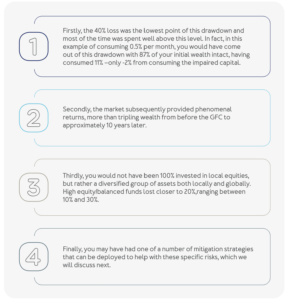Investment Centre
Sequence risk… when you need not worry about market volatility

Many articles and conversations make a big deal about sequence risk and how it should impact the way accumulated wealth is managed during the consumption phase of an investor’s life. While sequence risk certainly does matter, it can be mitigated by superior techniques rather than by compromising on an optimal investment strategy by trying to limit adverse risk events.
In this short piece I will focus on sequence risk and provide a different perspective on how to address it while maintaining an optimal investment strategy.
What is sequence risk?
Sequence risk is simply the risk of bad timing of returns in relation to withdrawals from wealth for consumption.
For example, if your portfolio loses 20% just before you make a large withdrawal, then your wealth would be permanently impaired as the amount withdrawn and consumed does not have an opportunity to recover when the markets do. Recognising that consumption of wealth generally happens over many years and sometimes decades, will assist in understanding that the time to most payments lies in the distant future, allowing any drawdowns time to recover.
When does sequence risk matter?
Sequence risk only matters when returns are negative – in other words, wealth is impaired – and drawdowns are made. It is also only the amount of wealth consumed and removed from the market that matters, since the rest of the wealth remains invested and has the opportunity to recover, sometimes long into the future.
An exception to this would be buying a life annuity at retirement – this would result in a full withdrawal from the market and the crystallisation of any loss, essentially locking in a lower pension for life. Sequence risk therefore matters most just before large withdrawals from the market, which should otherwise rarely happen as we will explore next.
When does sequence risk not matter?
Let us explore this by way of an example to show that in many instances, sequence risk should not matter all that much. Assume that you have saved enough for retirement and will be consuming from this ‘pot’ of money for the rest of your life.
You will want to limit your consumption each year so that you do not outlive your wealth. This will depend on many factors, but for simplicity let us assume that you set your initial consumption at 6% of your wealth per annum. That simply translates into 0.5% per month.
In the Covid-19 scenario where local equity markets were down circa 15% for March 2020, your entire wealth would have been down 15% if you were 100% invested in local equity, a highly unlikely situation. The 0.5% that you withdrew, an assumption that we can challenge later, for consumption would have been permanently impaired as it would not have had an opportunity to recover.
Unless you made the mistake of disinvesting because of fear, the rest of your wealth would have remained invested and would have rebounded by about 15% the very next month, in April 2020. The months that followed would have increased your wealth even further and a full year later, your 12-month return would have been in excess of 50%.Obviously this was a unique situation where markets recovered very quickly. Although other events could be much worse, it does illustrate the point that you would not have consumed your entire wealth right after the market draw down. But let us look at a worse situation to see how you would have fared.
In 2008 the Global Financial Crisis (GFC) saw the local equity market lose about 40% – measured monthly, not daily – of its value over a period of about nine months from top to bottom. It only took 13 months for the market to recover to its previous high, which means that you would have had to survive 22 months (9 months + 13 months) of consuming impaired capital or 11% of your wealth (0.5% x 22 months).While this is not insignificant, there are a couple of important points that could have mitigated this:

How can sequence risk be mitigated?
Many wealth managers address sequence risk through insurance strategies that protect your capital from some of the drawdown risks. While these are legitimate strategies, especially for investors that have little to no appetite for risk, they are generally costly and reduce overall returns for the investor. Again, this is not necessarily a problem as insurance is used in our daily lives to mitigate adverse outcomes and we are generally happy to pay for this peace of mind. However, these strategies are sub-optimal for some investors that can tolerate short term poor performance as has been demonstrated in the two examples above.
The big difference, however, relates to the concept of ‘ruin’. In a typical insurance scenario, you insure because of the risk of ruin from the occurrence of a risky event. You may not have enough money if your house burned down for example, so buying insurance to mitigate this risk is self-evident. At retirement, however, you do have a big pot of money and even a substantial market drawdown will not ‘ruin’ you immediately unless you lose 100%.Ruin may happen in the distant future if you eventually run out of money, but the market could recover well before that happens, potentially averting ruin completely.

The first, which has no cost at all to the investor, is to recognise that time provides a level of diversification. Although drawdowns can be deep and last a long time, they generally do not. On average, only 35 months for the worst 10 drawdowns in the past 100 years. They also recover fairly quickly, on average only 20 months for the worst 10 drawdowns in the last 100 years. Drawdowns by definition start with negative returns – this means that investors must have enjoyed positive returns before the drawdown starts. On average it only took 32 months to achieve the returns that would have been wiped out by the 10 largest drawdowns of the past 100 years. Most investors would have been invested for multiple decades before entering their consumption phase in retirement and thus, drawdowns can be seen in the context of these previously positive returns. The implication of this is, would be to perhaps set your consumption level at a lower initial level if you have enjoyed above average returns leading up to retirement.
A slightly more costly mitigation strategy, which does not otherwise compromise the investment strategy, and does not have direct costs related to portfolio insurance, is to hold some of your wealth in a lower risk strategy, or perhaps even a no-risk strategy.
This allows you to consume from unimpaired capital when markets are down and your risky investments alongside the market. A couple of years, perhaps two or three, should be more than adequate to see you through most ‘bad’ times. This ‘kitty’, which could be around 10% of your retirement savings, could be funded from excess returns from your risky portfolio, meaning that you would put some money aside when your portfolio performs better than required to meet your consumption needs.
In conclusion
Although market drawdowns can be difficult to live through, especially in retirement when living off the wealth you have accumulated over a lifetime, investors should understand these risks and how they can be mitigated without compromising on their long-term investment strategies through complex and costly alternatives.
Remaining invested and patient while others are fearful and making mistakes will go a long way to mitigate market volatility and sequence risk. Putting some of your wealth aside in a lower risk strategy can help to see you through large market drawdowns and give the balance of your wealth sufficient time to recover.
Key points:
- Market volatility can lead to sequence risks for investors in or approaching retirement.
- Assume you have saved enough for retirement. You do not need to compromise on an optimal investment strategy with complex and costly alternatives to mitigate these risks.
- Understand that very little of your wealth is at short-term risk and that time provides a level of diversification that will help to mitigate sequence risk.
